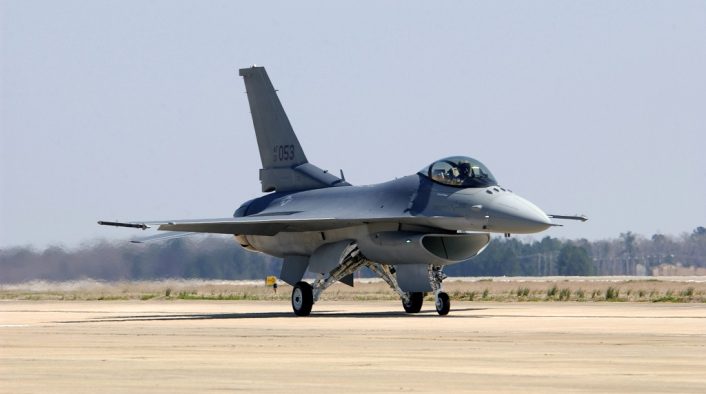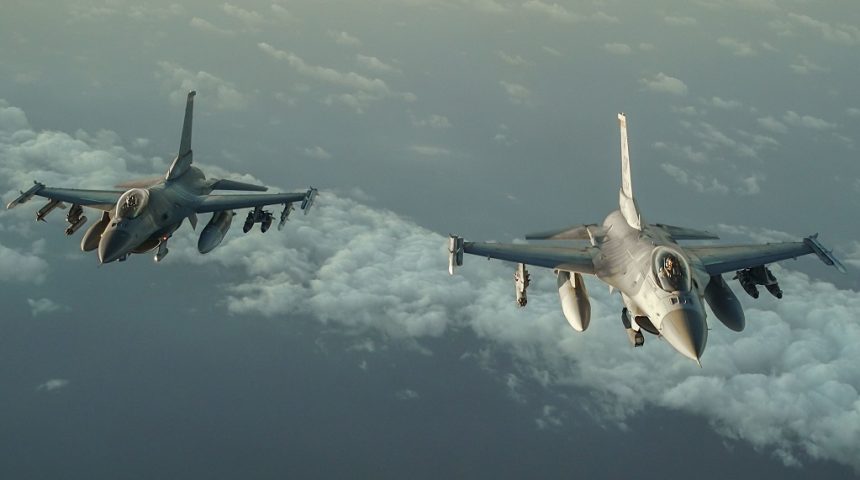More F-16 Vipers could be ordered together with F-15EXs, attritable aircraft and NGAD to replace older aircraft until enough F-35s are available.
Almost 16 years after the last delivery, the U.S. Air Force is now considering an order for new F-16 Fighting Falcon (or Viper, as the type is dubbed in the fighter pilot community) jets. This news was recently reported by the Aviation Week Defense Editor Steve Trimble after an interview with Will Roper, former Assistant Secretary of the Air Force for Acquisition, Technology and Logistics.
The last F-16C, the Block 50 CC-231 AF 01-7053, was delivered on March 18, 2005, and assigned to Shaw Air Force Base, South Carolina. This aircraft was the last of 2,231 F-16s produced for the Air Force and delivered from 1978. Since that first delivery the aircraft evolved and, from the original lightweight, daytime interceptor design, the F-16 has become a multi-role, all weather, air-to-air and air-to-ground attack weapon system. More than 1,300 jets are still in service in all the branches of the Air Force and they could continue to serve for a long time.
After the last USAF delivery, the production line in Fort Worth, Texas, went on assembling F-16s for international customers, until the last Iraqi F-16 delivery in 2017. After that, the production line was moved in Greenville, South Carolina, where it was inaugurated in 2019 and started working on manufacturing of the F-16 Block 70/72. In December 2020, the same facility was chosen for depot level maintenance and modernization support as part of a new 10-year F-16 Depot Sustainment Program awarded to Lockheed Martin.
“As you look at the new F-16 production line in South Carolina, that system has some wonderful upgraded capabilities that are worth thinking about as part of our capacity solution,” said Roper.
The reason for this new sustainment contract is that the F-16 was initially scheduled to be retired in 2025 and replaced by the F-35 Lightining II. However, budget restraints and a slower than expected delivery of the new 5th gen. aircraft, together with other factors, forced the service to revise its plans and initiate, about ten years ago, a Service Life Extension Program (SLEP) to keep the Viper in service at least until 2048.
Something similar happened to the F-15C, that was scheduled to be retired in 2019. However, while a first SLEP required only a replacement of the longerons to maintain structural integrity, the Eagles now need new wings, as they have long surpassed their expected service-life estimates. In 2019, the decision was made to allocate the funding for the first eight of at least 144 F-15EXs, as this would be a more practical solution than waiting for enough F-35s to be available to replace also the F-15C. Moreover, the Air Force is evaluating a reduction of the total order for the F-35 from the original 1,763 to “just” 1,050 aircraft.
This way the Air Force, that was initially planning an all-stealth fleet of F-22s and F-35s only, is now adding F-16s and F-15EXs in the Fiscal Year 2023 budget request, together with an attritable aircraft and a next-generation fighter.
There are no details about the number of new F-16s, their configuration and the aircraft they would replace. The F-16 production line, as mentioned before, is now manufacturing the new Block 70/72 variant, which features a lot of enhancements over the most recent USAF Block 50/52 Vipers.

Among the new systems, we can find the APG-83 AESA (Active Electronically Scanned Array) radar, a new Center Pedestal Display (CPD)/Center Display Unit (CDU), the AN/APX-126 Advanced IFF (Identification Friend or Foe), Link 16 datalink, full NVIS (Night Vision Imaging System) and JHCMS II (Joint Helmet-Mounted Cueing System II) compatibility, a new Embedded GPS/INS (EGI), a modern commercial off-the-shelf (COTS)-based avionics subsystem, a high-volume, high-speed data bus and the Automatic Ground Collision Avoidance System (Auto GCAS).
Many of these components are being integrated already on the F-16s currently in service in the Air Force, like the APG-83 declared operational by the Air National Guard, the CDU (already installed on ANG Block 30 aircraft and with a contract awarded for installation on Block 40/42 and 50/52), Link 16 and AGCAS. Having considered this, it is safe to assume that, if the Air Force will proceed to order new F-16s, they will be in the Block 70/72 configuration.
As for which F-16s will be replaced by the new ones, that is not known. However last year, Gen. Mike Holmes, then head of Air Combat Command, said that the about 232 Block 25 and Block 30 F-16C/D jets, known also as “pre-block” F-16s, could be replaced by attritable aircraft in the 2024-27 timeframe. Should this decision be confirmed, the F-16s Block 70/72 could replace the Block 40/42 and even the Block 50/52 jets, depending on how many will be bought.
Roper gave some more details about this attritable aircraft option during the interview with Aviation Week. These could be the same Unmanned Aircraft System (UAS) used for the Skyborg program, intended to perform a variety of different missions and cheap enough to accept heavy losses, and, more interestingly, could even act in the adversary role during training.
“I think, at a minimum, attritables ought to take on the adversary air mission as the first objective,” Roper said. “We pay a lot of money to have people and planes to train against that do not go into conflict with us. We can offload the adversary air mission to an artificially intelligent system that can learn and get better as it’s doing its mission.”
Some might argue why the Air Force needs new F-16, instead of continuing only with the orders for the F-35 or the attritable unmanned aircraft. The reason is simple and similar to the one for the F-15EX. The F-22 and the F-35, to preserve their low observability, can carry weapons only internally and this restricts both the quantity and the dimensions of the weapons. The F-16 and F-15EX do not have this limitation and they could follow the two stealth aircraft while carrying a lot of standoff weapons and, especially in the case of the F-15EX, even hypersonic weapons.
Moreover, stealth is not always required, so the cheaper F-16s and F-15EXs can be used in those occasions instead of the F-22s and F-35s, saving some precious time on the service life of the Radar Absorbing Materials that, if damaged during a flight, might significantly degrade the low observability of the aircraft.
As a side note, with the new international orders for the Fighting Falcon in the last few years, Lockheed Martin is closing on the 5,000th delivered F-16 mark. In September 2020, the late Lockheed Martin Executive Vice President of Aeronautic Michele A. Evans said that the company delivered about 4,600 aircraft with a backlog of 130 more, and they see increasingly possible to reach 5,000.









